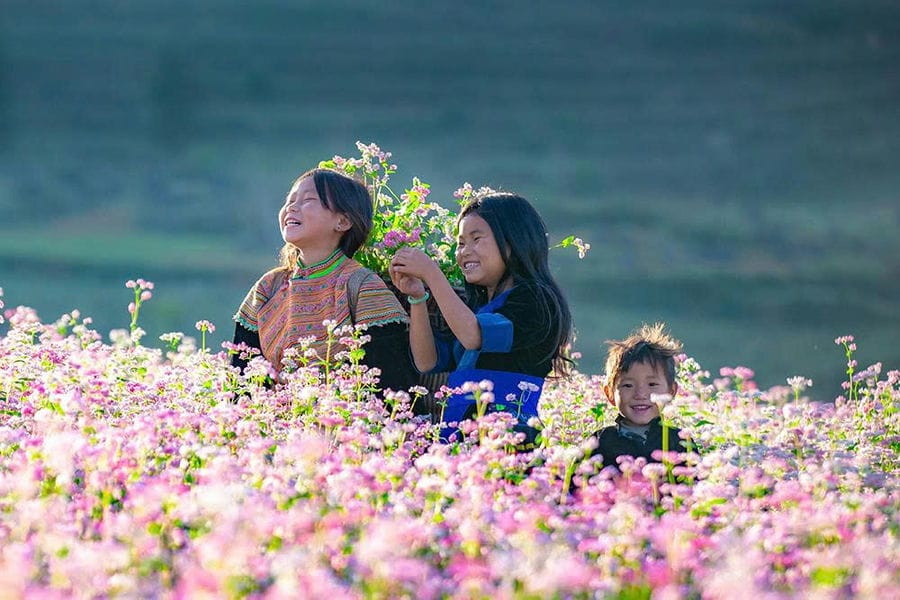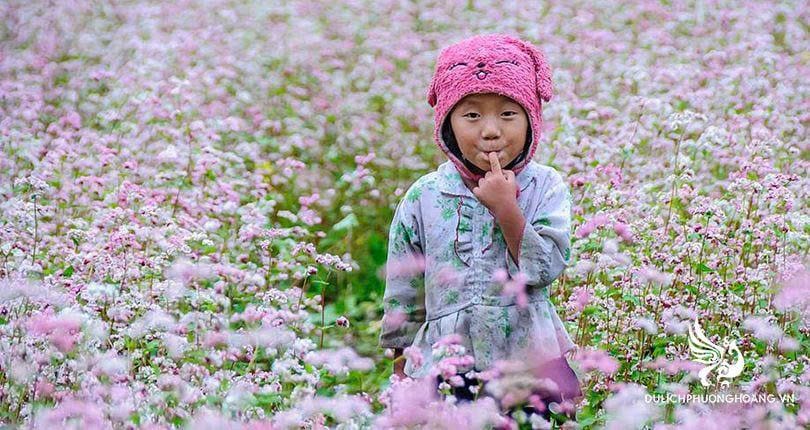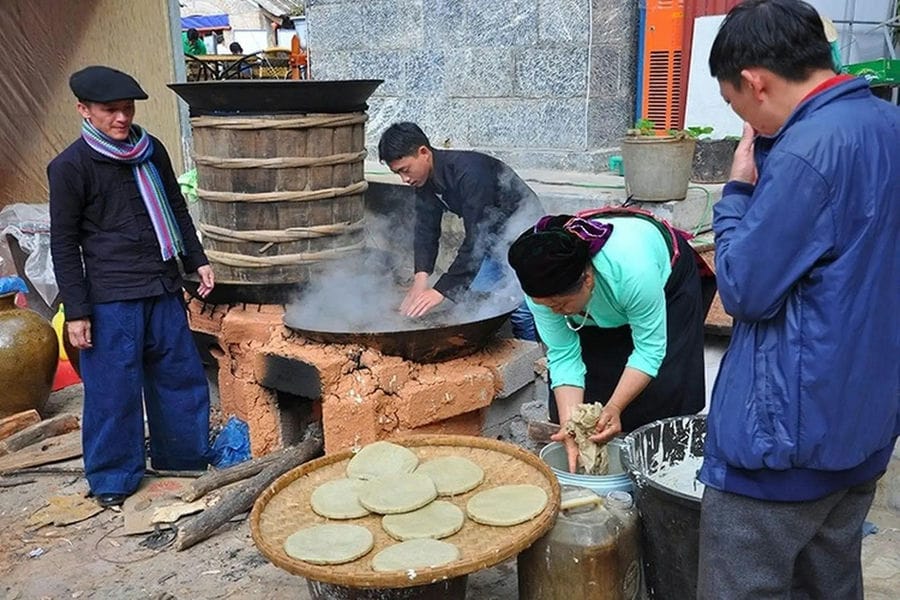Buckwheat Wonders: From Mountain Bloom to Highland Treat in Hà Giang
When autumn arrives, Hà Giang’s rocky plateau dons a delicate pink veil of blooming buckwheat flowers. Hillsides, mountain slopes, and valleys all burst into romantic, captivating beauty, leaving tourists spellbound as they wander through this stony land.

Buckwheat – The Autumn Messenger of the Rocky Mountains
Buckwheat is a delicate yet hardy plant that finds life even in the narrow cracks of rugged mountain rocks. Though it grows in rugged, unforgiving terrain, the buckwheat flower thrives—standing as a quiet symbol of endurance and harmony with the rocky soul of Hà Giang’s mountains.
From October through December, the blossoms undergo a gentle transformation in color — beginning as pristine white, then gradually turning blush pink, and finally soft lavender. These shifting shades create a dreamlike landscape, adding a touch of gentle charm to the region’s dramatic mountain backdrop.
For highland communities, especially the Hmong and Dao people, buckwheat is more than a beautiful flower. It is a symbol of vitality, perseverance, and deep-rooted connection to their ancestral land.
The Buckwheat Bloom – A Seasonal Invitation to Embrace Nature
When the buckwheat flowers begin to blossom, Hà Giang welcomes a wave of nature lovers and photography enthusiasts.
Tourists from all corners of Vietnam and beyond are drawn to stunning destinations like Lũng Cú, Sủng Là, Phó Bảng, and the remote highlands of Hoàng Su Phì, where rolling hills blanketed in buckwheat flowers create an idyllic backdrop for memorable experiences and photography. People come onlyjust to admire the flowers, but to breathe in the fresh mountain air, feel the gentle autumn chill, and soak in the purity of untouched nature.
During buckwheat flower season, Hà Giang becomes a romantic place for many couples seeking to capture their pre-wedding memories amidst the dreamy floral landscapes. Girls in vibrant traditional brocade costumes walking through the floral fields create scenes that seem to step out of a painting—both rustic and ethereal.

The Journey of Cultivating the Stone-Born Flower
Grown in rocky soil and harsh weather, buckwheat blossoms thanks to the quiet perseverance and traditional knowledge of upland farmers. After the upland rice harvest—usually in late August or early September—locals begin sowing buckwheat seeds into the rugged fields and stony hillsides, places where few other crops can grow.
The tiny seeds are carefully selected, then scattered by hand across the land and lightly covered with a thin layer of soil. No chemical fertilizers or pesticides are used. Instead, the plants rely solely on the sun, wind, dew, and the nutrients of the mountain soil to grow—becoming a symbol of resilience and harmony with the land. Watering is kept to a minimum, done only when required, while farmers continuously remove weeds to support uniform development.
Although it doesn't require modern farming techniques, cultivating buckwheat demands observation, timing, and a love for the land to less impressive landscapes and possibly impacting the tourism-based income that many families rely on during the flower season. Thanks to the steady and skillful efforts of local farmers, the highland slopes burst into coordinated color each fall, turning the stone-strewn terrain into a breathtaking floral canvas.
The Buckwheat Flower Festival – A Celebration of Highland Culture
Since 2015, the Buckwheat Flower Festival in Hà Giang has become an annual cultural highlight, drawing thousands of visitors from Vietnam and abroad. More than a chance to admire the flowers, the festival is a celebration of ethnic identity and traditional heritage, showcasing the rich culture of ethnic groups like the Hmong, Dao, Tày, and Lô Lô.
The festive atmosphere bursts forth as mountain markets buzz with vibrant activity, while traditional melodies and dances echo across the hills, breathing life into every corner of the highlands. Guests can enjoy colorful parades of buckwheat flowers, admire ethnic attire on display, and join in lively folk games rooted in local customs such as stick pushing, tug-of-war, and shuttlecock throwing.
A highlight of the celebration is the chance to taste genuine regional dishes like thắng cố, mèn mén, rustic buckwheat cakes, and the strong yet fragrant corn wine brewed by hand in the villages. Locals eagerly welcome travelers to sample their home-cooked meals, try on beautifully crafted ethnic clothing, and experience the rhythm and soul of life in the highlands.
The festival is not merely a celebration for visitors, but a heartfelt tribute to the enduring spirit of highland communities — reflecting their ingenuity in overcoming adversity and their profound harmony with nature and ancestral customs.. It is also a reminder—for young people and travelers alike—of the beauty not only in the flowers, but in the people and culture that nurture them.

Buckwheat Cakes – Flavors Carved from the Highland Soil
Beyond its romantic beauty, buckwheat plays a modest yet meaningful role in the everyday meals of upland communities in northern Vietnam. After the blooming season, its tiny seeds are carefully collected, sun-dried, and milled into a fine, earthy flour. From these tiny seeds, locals craft cakes with distinctive flavors — soft and chewy with a subtle aroma — often enjoyed warm alongside a cup of corn tea or a glass of homemade corn wine.
The growth of tourism has made buckwheat an important source of livelihood for many communities in Hà Giang. However, the key challenge is preserving its natural charm, ensuring it doesn’t become overly commercialized.
Each cake carries the essence of the highlands: born from rocky soil, crafted with sweat and care by the hands of local mothers and sisters. Simple as they may seem, these rustic cakes often leave a lasting impression on travelers, who take them home as meaningful souvenirs — a way to preserve the taste and memory of the highlands.
Today, various localities celebrate the blooming season with buckwheat flower festivals, not only to showcase the beauty of their homeland but also to preserve traditions and attract eco-conscious travelers. However, tourists who come to admire, photograph, or enjoy buckwheat products should show respect for nature: avoid trampling the flowers and littering, so that this fragile flower can continue blooming on the rocky plateau every autumn.




.jpg)


